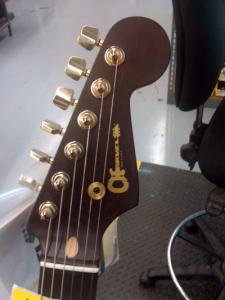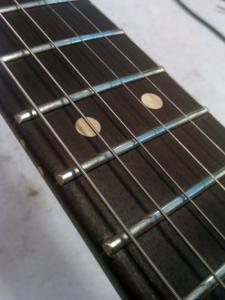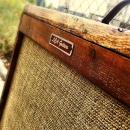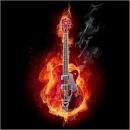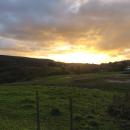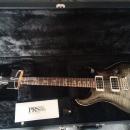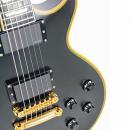#1 Según decían en Charvel, que fué donde primero leí hace años lo del Arce tostado (aunque Gibson lo usó después en diapasones ) las ventajas es que se elimina todo el agua que pueda quedar y se acaban de secar.
No sé si alguna vez has querido hacer uan garrota o algo de una rama que quieras que dure, hay que pasarlo por el fuego para que se estabilice, más o menos será la misma teoria.
Aparte lo hacen en camaras y bastante temperatura, según decían olia el mástil a humo y al princio Charvel lo usaba en el custom shop.
Esto es lo que decía la propaganda de Charvel.
Carbonized Charvel San Dimas Guitars
Charvel, Charvel San Dimas, Cooked Wood, Custom Runs, Custom ShopAdd comments
We’d like to introduce you to our latest Music Zoo Exclusive Custom Run, the Charvel Carbonized San Dimas. We are extremely excited about these revolutionary guitars, which were conceptualized after we discovered a source of specially kiln-dried wood this January at the Winter NAMM Show. Our friends at the Charvel Custom Shop, who have been building our Natural Series and Nitro Aged Series guitars for some time, are the perfect choice to realize these unique instruments. Follow the jump to learn about what makes a Carbonized San Dimas.
Kiln-drying is an age-old technique used to season wood for use in building instruments, but this new process takes kiln-drying a step further. The wood is essentially cooking in a pressurized kiln in its own moisture and gasses as they escape. This process carbonizes the wood, giving it this dark rich color and locking the moisture content around 10 percent. This means that the wood will not take on moisture nor release moisture during its life, which keeps it from being susceptible to climate and humidity changes as the seasons change or as the cities change on tour. This equals fewer neck adjustments and playing issues over the lifetime of the instrument. The release of this moisture also greatly reduces the weight of the wood, making for lightweight and ultimately more resonant necks and bodies.
After the carbonizing process, the hard and light wood mills beautifully. The builders at Charvel were extremely excited about how clean and smooth each cut was, and how that translated ultimately to the feel each neck was going to have. In addition, we all noted that the wood had a nice “smoked” aroma about it too; an added bonus. Not all woods react well to this process we are told, but luckily maple does which is of course perfect for our neck. The bodies are done using Abella which is from the walnut family, though closer in tone to alder which is very traditional for guitar making. We decided to build these out with two direct mounted pickups, low friction pots, crown head tuners, a light oil finish and your choice of Floyd Rose or NOS tremolo. Our prototypes literally scream. The ones we’ve seen are well under 7lbs with a deep woody attack off the body and overtones for days. The stability and quality of the wood through this process are on their own ideal for building, but the functionality and sound of the end product is the part we are extremely pleased about being able to offer to our customers. These are currently coming through production and will be available routinely as Music Zoo Exclusive. Please contact us for more info, or to pre-order.
Archivos adjuntos (
loguéate para descargar)
Charvel Custom Shop Exclusive Carbonized 160.doc

en youtube hay comparaciones entre ambos y en principio si parece notarse la diferencia

Basicamente es lo que te han explicado: se consigue que la madera sea mas "estable" y menos sensible a los cambios de temperatura y humedad. Si eres un musico que gira continuamente y va de un lado a otro evidentemente es un avance en ese sentido, ya que necesitara menos ajustes por no decir ninguno. En cuanto a sonido, siempre que he preguntado antes de encargar una guitarra a los dealers, me han dicho que ellos no notan ninguna diferencia, mas alla de la que se puede notar entre dos mastiles por el hecho de ser piezas individuales. El sonido esta en el mismo rango. Y esteticamente pues el tostado se quedaria con un color caramelo y si te empeñas, directamente marron (los chocolate maple neck de TAnderson o los vulcanized que llamaba Suhr a los suyos cuando empezo a ofrecerlos), mientras que el no tostado .... bueno del color de siempre. A mi personalmente desde el punto de vista estetico me parece un color horroroso, pero es una cuestion de gustos. A otro le pueden parecer la cosa mas bella sobre la tierra.
Otra cosa, es que segun Warmoth no necesita ningun tipo de lacado ya que la madera al hornearla y cambiar sus propiedades fisicas queda ya sellada, mientras que los fabricantes de guitarras siempre le ponen algo.

 Baneado
Baneado
Entonces, al secar artificialmente la madera, se consigue más estabilidad de afinación ante cambios de temperatura... Pero el tono del arce se mantiene, no?

 Baneado
Baneado
Entonces, al secar artificialmente la madera, se consigue más estabilidad de afinación ante cambios de temperatura... Pero el tono del arce se mantiene, no?

 Baneado
Baneado
Lo suyo sería probar el màstil antes y después del proceso.... Yo no lo he hecho. Ni nadie que conozca. Tampoco sé de alguna prueba subida a Internet por ese motivo.
Lo que si sé:
Presentan un acabado satinado. Y es el màs agradable de todos al tacto. Para mí al menos. Se sienten mucho màs ligeros. Y son màs resonantes. Notas mucho màs la vibración en la mano. Y toda las guitarras que lo montaban (gama alta) tenían un sonido excepcionalmente claro.

1



